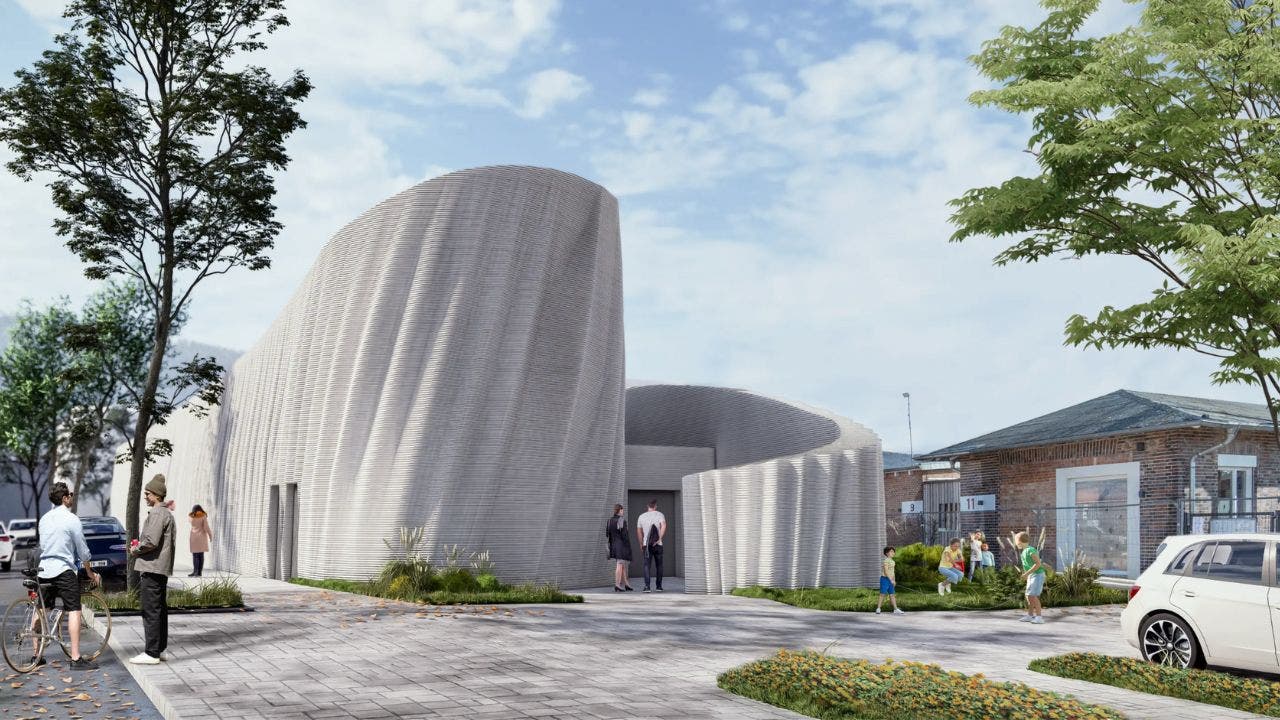In the heart of Germany, a groundbreaking project has emerged, marrying the worlds of technology and architecture in a way never seen before.
The Wave House, a new data center located in an urban area of Heidelberg, stands as a testament to innovation, being Europe’s largest 3D-printed building to date.

The Wave House. (COBOD International)
A stylish solution to a utilitarian problem
Data centers, the backbone of our digital lives, are often relegated to nondescript, windowless buildings due to security and operational requirements. However, the push to bring these essential facilities closer to urban centers demanded a rethink in their design approach.
MORE: THE DIZZYING VIEWS FROM THIS ENTIRE GLASS HOUSE ROTATING 360 DEGREES

The Wave House is located in Germany. (COBOD International)
Enter the Wave House, which challenges the status quo with its visually arresting wave-designed walls — a feature that not only lends the building its name but also marks a significant departure from conventional data center aesthetics. It measures 6,600 sq. ft. and was designed by SSV and Mense Korte and created by Peri 3D Construction for developer KrausGruppe.
FISH FILET CREATED VIA 3D PRINTER MAY BE HITTING MARKET IN THE NEAR FUTURE

The Wave House was built in record time. (COBOD International)
The power of 3D printing in construction
The distinctive curvature of the Wave House’s walls could not have been achieved through traditional building methods. Instead, the project leveraged 3D construction printing technology, specifically the COBOD BOD2 printer.

The Wave House used 3D construction printing technology. (Kraus Gruppe)
This machine pushed out a recyclable cement-like mixture to form the building’s exterior. Achieving an impressive rate of 43 square feet per hour, the printer completed the walls in just 140 hours, demonstrating the efficiency and versatility of 3D printing in modern construction.

The Wave House’s walls were completed in 140 hours. (Kraus Gruppe)
MORE: A BIRDHOUSE-INSPIRED TINY HOUSE NESTLED IN NATURE THAT RUNS ON SOLAR POWER
Environmental and economic impacts
Beyond its aesthetic appeal, the Wave House represents a stride forward in sustainable building practices. The 3D-printed construction process emits significantly less CO2 compared to traditional methods, aligning with global efforts to reduce the environmental footprint of new developments.
Furthermore, the project showcases the potential for reducing costs and construction times, making it a compelling case study for future urban planning initiatives.
GET FOX BUSINESS ON THE GO BY CLICKING HERE

The Wave House is Europe’s largest 3D-printed building. (Kraus Gruppe)
MORE: HOW THIS TINY HOUSE FLIPS ITS DESIGN WITH UPSIDE DOWN LAYOUT
A milestone for 3D-printed architecture
The inauguration of the Wave House not only marks a significant advancement for the construction industry but also signals the growing acceptance of 3D-printed architecture in mainstream applications. From earthquake-resistant homes to ambitious developments of 100 3D-printed houses, the technology is proving its worth across a diverse range of projects.
COBOD, the company behind the technology, aims to automate at least 50% of building site processes, promising efficiency gains and potentially reshaping the labor landscape in construction.

The Wave House. (Kraus Gruppe)
Kurt’s key takeaways
The Wave House in Heidelberg is more than just a data center; it’s a symbol of architectural innovation and a showcase for the potential of 3D printing in construction. By blending functionality with style, the project addresses the evolving needs of urban infrastructure and sets a new standard for data centers worldwide. As 3D printing technology continues to evolve, we can expect to see more projects that challenge traditional architectural norms, offering sustainable, efficient and visually compelling solutions for the cities of tomorrow.
CLICK HERE TO GET THE FOX NEWS APP
Do you worry that 3D-printing construction will eliminate existing jobs in the construction industry?Let us know by writing us at Cyberguy.com/Contact
For more of my tech tips & security alerts, subscribe to my free CyberGuy Report Newsletter by heading to Cyberguy.com/Newsletter
Ask Kurt a question or let us know what stories you’d like us to cover.
Answers to the most-asked CyberGuy questions:
Copyright 2024 CyberGuy.com. All rights reserved







